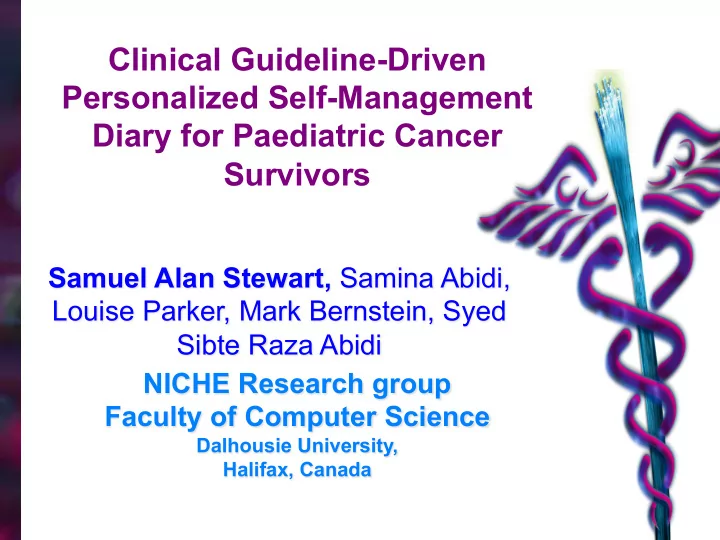

Clinical Guideline-Driven Personalized Self-Management Diary for Paediatric Cancer Survivors Samuel Alan Stewart, Samina Abidi, Louise Parker, Mark Bernstein, Syed Sibte Raza Abidi NICHE Research group Faculty of Computer Science Dalhousie University, Halifax, Canada
Outline v Introduction v Shared Decision Making v YouCan framework v The YouCan system v CPG Computerization v CPG Execution v Diary Composition v Results v Example and preliminary implementation v Discussion and future work
Introduction v Pediatric cancer survivors face a lifetime of follow-up care v Cancer survivors are provided with a self-management program with information on v how to interpret and manage symptoms v how to make healthy lifestyle choices v how to deal with specific situations v how to manage their therapy plan v It is important to engage patients in the design of this follow- up program v Personalize it with respect to their conditions and preferences, as this will improve overall satisfaction
Shared Decision Making (SDM) SDM is a patient-centered care paradigm where clinicians and patients leverage the best available evidence to make decisions together about the best management of their care v Engaging patients in the care process has been shown to lead to better communication, better task orientation and improvement of quality of life v Key to SDM is the incorporation of evidence v Pertinent aspects of a Clinical Practice Guideline (CPG) are discussed with the patient v Through this process a self-management program is formulated
YouCan System v The YouCan system is designed to facilitate long-term follow- up care of survivors of childhood cancer v It is based on the concept of SDM, using a computerized version of a cancer follow-up CPG v “Guideline for Long Term Follow-Up for Survivors of Childhood, Adolescent, and Youth Adult Cancers” v YouCan personalizes the CPG based on the patient’s v Current therapeutic regiment v Health v Psychosocial behavior v Recommends relevant, evidence-informed self-management activities
YouCan System
Methods v Knowledge-management approach using semantic web technologies v YouCan is comprised of three components CPG Computerization 1. CPG Execution 2. Diary Composition 3.
CPG Computerization v We used our own ontology to computerize the CPG, resulting in the YouCan Ontology (in OWL-DL). v Serves as the basis for the SDM rules that guide the SDM session v The premise of a rule is a combination of therapeutic agents (drugs) together with patient attributes and preferences v Body of the rule contains recommendations from the CPG v Recommendations are classified into three categories v Things you need to know v Things you need to do v Things to talk to your doctor about
CPG Execution v SDM Rules are executed based on the survivor’s profile v Therapeutic agents used v Personal attributes v Management preferences v A Pellet reasoner executes the SDM rules, applying the patient information to the SDM rules to extract a pertinent set of recommendations
Diary Composition v A diary template is prepared with the following sections v Introductory information v diagnosis summary v treatment summary v self-management recommendations v information about conditions and potential complications v next steps v Sections are populated by the SDM rules and recommendations are embedded within the diary
Results v The knowledge modeling was done by two domain experts v Over 600 SDM rules were created v 110 drug side-effect interactions for 22 therapeutic agents v Using the SDM rules and the template, a 5-10 page self- management diary is produced and given to the patients. v Consider the following patient as an example: v 15 year-old male, diagnosed with Astrocytoma in March 2001 v Received chemotherapy, radiotherapy and surgery, beginning in January 2001 and ending in December 2004 v I’ll start with an example of a single rule set (Bleomycin, a chemotherapy agent), and then present his entire diary
Bleomycin v Some rules fire regardless of patient information v Other rules are dependent on: v Dose v Patient demographics v Comorbidities v Concurrent Treatments
Diary Example: Pages 1 and 2
Evaluation v In phase 1, domain experts evaluated the SDM rules for their clinical validity v Complete, some rules were adjusted, rules base is confirmed as valid v In phase 2, rules execution was evaluated for completeness and consistency v Rules were manually checked by knowledge-modelling experts v Sample clinical cases were passed through the system v Rules based is now confirmed as accurate v In phase 3, sample diaries will be field tested with physicians, nurses and patients for content and layout v Ethics received, study is currently underway v In phase 4, a pilot study will be conducted with the Children’s hospital in Halifax
Discussion v Management of pediatric cancer survivors is challenging v The use of SDM principles allows engagement in care plan v The YouCan framework produces a personalized self- management diary that facilitates the SDM process v The diary is being embedded within the CYP-C portal (an electronic health record for the clinical management of all pediatric cancer cases in Canada) v The SDM based and CPG-guided self-management service can be extended to youth survivors from other provinces. v In the future we plan to deliver the survivor’s self- management diary through a secure web app that will be accessible to survivors by mobile devices.
THANK YOU Questions?
Recommend
More recommend